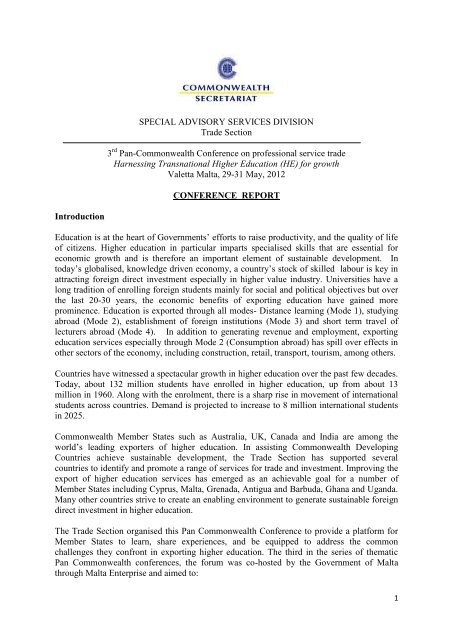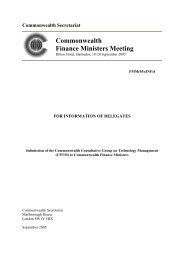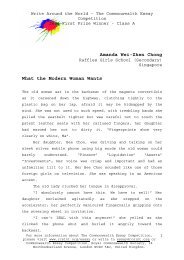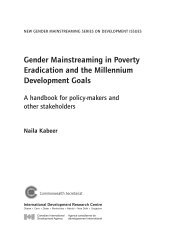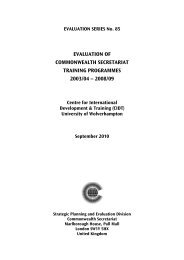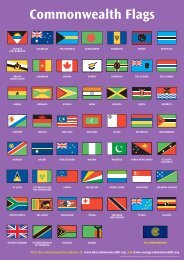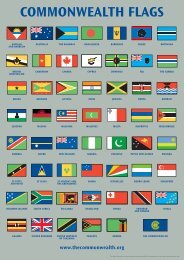SPECIAL ADVISORY SERVICES DIVISION Trade Section 3 Pan ...
SPECIAL ADVISORY SERVICES DIVISION Trade Section 3 Pan ...
SPECIAL ADVISORY SERVICES DIVISION Trade Section 3 Pan ...
Create successful ePaper yourself
Turn your PDF publications into a flip-book with our unique Google optimized e-Paper software.
Introduction<br />
<strong>SPECIAL</strong> <strong>ADVISORY</strong> <strong>SERVICES</strong> <strong>DIVISION</strong><br />
<strong>Trade</strong> <strong>Section</strong><br />
3 rd <strong>Pan</strong>-Commonwealth Conference on professional service trade<br />
Harnessing Transnational Higher Education (HE) for growth<br />
Valetta Malta, 29-31 May, 2012<br />
CONFERENCE REPORT<br />
Education is at the heart of Governments’ efforts to raise productivity, and the quality of life<br />
of citizens. Higher education in particular imparts specialised skills that are essential for<br />
economic growth and is therefore an important element of sustainable development. In<br />
today’s globalised, knowledge driven economy, a country’s stock of skilled labour is key in<br />
attracting foreign direct investment especially in higher value industry. Universities have a<br />
long tradition of enrolling foreign students mainly for social and political objectives but over<br />
the last 20-30 years, the economic benefits of exporting education have gained more<br />
prominence. Education is exported through all modes- Distance learning (Mode 1), studying<br />
abroad (Mode 2), establishment of foreign institutions (Mode 3) and short term travel of<br />
lecturers abroad (Mode 4). In addition to generating revenue and employment, exporting<br />
education services especially through Mode 2 (Consumption abroad) has spill over effects in<br />
other sectors of the economy, including construction, retail, transport, tourism, among others.<br />
Countries have witnessed a spectacular growth in higher education over the past few decades.<br />
Today, about 132 million students have enrolled in higher education, up from about 13<br />
million in 1960. Along with the enrolment, there is a sharp rise in movement of international<br />
students across countries. Demand is projected to increase to 8 million international students<br />
in 2025.<br />
Commonwealth Member States such as Australia, UK, Canada and India are among the<br />
world’s leading exporters of higher education. In assisting Commonwealth Developing<br />
Countries achieve sustainable development, the <strong>Trade</strong> <strong>Section</strong> has supported several<br />
countries to identify and promote a range of services for trade and investment. Improving the<br />
export of higher education services has emerged as an achievable goal for a number of<br />
Member States including Cyprus, Malta, Grenada, Antigua and Barbuda, Ghana and Uganda.<br />
Many other countries strive to create an enabling environment to generate sustainable foreign<br />
direct investment in higher education.<br />
The <strong>Trade</strong> <strong>Section</strong> organised this <strong>Pan</strong> Commonwealth Conference to provide a platform for<br />
Member States to learn, share experiences, and be equipped to address the common<br />
challenges they confront in exporting higher education. The third in the series of thematic<br />
<strong>Pan</strong> Commonwealth conferences, the forum was co-hosted by the Government of Malta<br />
through Malta Enterprise and aimed to:<br />
1
� Expose participants to emerging trends and opportunities to export HE<br />
� Share good practice in addressing challenges in exporting HE<br />
� Share perspectives on how to harness transnational HE for global prosperity<br />
� Encourage greater collaboration and networking among providers, policy makers and<br />
experts in Commonwealth countries.<br />
The conference attracted a total of 45 participants from Government ministries, regulatory<br />
bodies, trade promotion organisations and universities. The thematic areas addressed<br />
included:<br />
� Trends and issues in internationalisation of HE<br />
� Opportunities and challenges of exporting HE<br />
� Cross cutting issues in international HE<br />
� Facilitating transnational HE through collaboration<br />
� The conference programme is attached as Annex B.<br />
Opening session<br />
Welcoming participants, Dr Nicole Lungaro Mifsud, Director, Multilateral and Global Issues,<br />
Ministry of Foreign Affairs, Malta noted that the 2005 Commonwealth Heads of Government<br />
Meeting (CHOGM) in Malta recognised the contribution of international trade to global<br />
prosperity, poverty elimination and sustainable development. Further, the CHOGM in Perth,<br />
in October 2011 agreed to explore options on higher education, in particular for sharing best<br />
practise on resource management and providing initiatives to provide access to research. The<br />
position of Malta with regards to the Commonwealth has changed from the recipient of<br />
Technical Assistance to building capacity of member countries through Malta-<br />
Commonwealth Third Country Training Programme which has trained over 1,250<br />
Commonwealth officials. Besides Malta also helped to establish COMNET-IT and supported<br />
the Virtual University for Small States. The full speech is presented in Annex C.<br />
Estella Aryada, Adviser and Acting Head (<strong>Trade</strong> <strong>Section</strong>), Commonwealth Secretariat<br />
provided an oversight on the background to the conference, its objectives, modus operandi<br />
and expected outcomes. She drew attention to the Conference programme and expressed her<br />
gratitude to Ministry of External Affairs Govt. of Malta and Malta Enterprise for their<br />
support in organising the conference. A summary of the Secretariat’s involvement in HE and<br />
modalities of assistance is presented in Annex D.<br />
The Key note address was delivered by Prof Alfred Vella Pro Rector University of Malta on<br />
the theme of ‘Transnational higher education for global growth and prosperity’. He noted<br />
that small states have to manage their affairs carefully because of their uniqueness and ensure<br />
that higher education is not jeopardized by Transnational Education (TNE) providers who do<br />
not meet the required or expected standards. The presence of foreign students enriches the<br />
campuses culturally which benefits the whole community of learners and teachers. The<br />
current partnering arrangements in Malta with prestigious American universities which<br />
utilises only Maltese and American teaching staff with no virtual teachers is bringing dual<br />
benefit by a) providing students with the opportunity to receive awards that are certified by<br />
both a European and a US institution and (b) creating a conducive environment towards<br />
collaborative research. In Malta, franchised higher education (mainly from UK institutions) is<br />
particularly active in providing IT and business education since they fill an existing gap,<br />
delivering important social and economic benefits and minimising brain drain. He however<br />
2
cautioned about the risks associated with educational provision obtained against payment<br />
from overseas operators, especially, by distance learning since such qualifications are<br />
generally not accompanied by detailed transcripts which makes it difficult to evaluate or<br />
harmonise with similar qualifications. It was emphasised that the local bodies responsible for<br />
quality assurance of higher education need to be sufficiently resourced to take on the task of<br />
controlling and regulating TNE operators. In his concluding remarks the keynote speaker<br />
identified that in this age of lifelong learning and especially as the economic performance of<br />
a country depends on the education of its workforce, higher education cannot be allowed to<br />
be exploited and abused by unprincipled TNE operators. The full keynote address is attached<br />
as Annex E.<br />
Theme 1: Exporting Education: emerging trends and issues<br />
1.1 An overview - Neil Kemp<br />
The international market for HE continues to grow faster especially in Asia and Africa<br />
because of increasing demand and decline in public funding for HE. Some new destinations<br />
such as Malaysia, China, and Mauritius have emerged. The numbers of globally mobile<br />
students are about 2% of the total numbers enrolled across the world. The top 6 countries<br />
(US, UK, France, Australia, Germany, Japan) host 62% of all international students.<br />
Immigration and high cost are major barriers to student mobility. Other export activities are<br />
also equally important such as research, staff recruitment and research contracts. For most<br />
state universities involved in TNE, export activity is part and parcel of their wider<br />
internationalisation strategies. In the context of UK it was noted that there are now similar<br />
numbers of students enrolled for a degree outside the UK as there are on UK campuses.<br />
Regional hubs are evolving for student mobility, TNE and other cooperative ventures. While<br />
on-line delivery offers many opportunities serious concerns was expressed regarding being<br />
able to distinguish bogus operators from the genuinely accredited. There is a rapid expansion<br />
of private sector HE companies operating internationally through partnerships, investment<br />
and full scale ownership. The demand for HE is highest in business & management, finance,<br />
electronics and, computing. The greatest mobility is within regions and historic and language<br />
relationships are important in the selection of destinations for higher education. However, the<br />
impact is global. In exporting HE, it is important to get the business model right. Despite<br />
having the right technical and financial resources, some foreign campuses have closed after<br />
only a few years in operation. The presentation is attached as Annex 1.1<br />
1.2 Issues and prospects for developing countries- Sajitha Bashir (by video link)<br />
In highlighting the issues and prospects for developing countries (Annex1.2), Dr Sajitha<br />
Bashir stated that data indicate that in spite of the economic meltdown of 2008-09 there was<br />
no decrease in the number of students going abroad for higher education. The data further<br />
reveals that Asia is a big importer of higher education. The factors responsible for creating<br />
demand are (a) limited capacity for domestic tertiary education (b) low quality in disciplines<br />
in high demand and (c) higher rate of return on internationally recognized qualifications. A<br />
major problem facing the sector is lack of communication between Ministries of Education<br />
and Ministry of <strong>Trade</strong> and lack of a coherent education sector strategy. Equity is also a matter<br />
of concern as it is emerging that it is mostly rich learners who are benefiting from higher<br />
quality, foreign provided, education. There are also concerns that foreign education within a<br />
country is creating a two-tier higher education system. Some negative effects of foreign<br />
education on domestic institutions is that local institutions cannot withstand competition from<br />
well-established public and private foreign universities. Foreign institutions will create<br />
competition for well qualified and experienced university teachers. Developing countries run<br />
3
the risk of attracting low quality foreign providers, who rely on a “foreign” name but offer<br />
limited range of programmes. Some instruments that could be used for regulating foreign<br />
institutions are domestic quality assurance agencies; quality assurance mechanisms of<br />
exporting countries; and regular due diligence to ensure that the programmes offered are<br />
accepted by employers. There is need for closer collaboration between the ministries<br />
responsible for trade, and those for higher education. Ministries of trade should take the lead<br />
in trade policy (negotiations with other countries) but education ministries need to be<br />
involved at the technical level. In order to have a strong external negotiating stand it is<br />
important to have an understanding of the domestic education context especially the current<br />
drivers of domestic demand, the interests of external providers and as much information as<br />
possible about the external provider. It is also important to have an understanding of the<br />
domestic regulatory mechanisms and the country’s goal in higher education.<br />
1.3 Malaysia’s education export in the 21 st century- Ismail Abd Aziz.<br />
In Malaysia, trade in HE has emerged because of the country’s efforts to strengthen and<br />
increase its skilled workforce to accelerate the country into a high-income economy status.<br />
Malaysia introduced the Private Higher Education Institution Act in 1996. This led to the<br />
liberalization of its higher education sector which allowed foreign higher education<br />
institutions to set up branch campuses in collaboration with local partners. The sector has<br />
seen high growth post September 2001 as students responded to the stricter immigration<br />
requirements from SE Asia to the US. In 2007 Malaysia launched the National Higher<br />
Education Strategic Plan 2020 as a blueprint for developing a globally recognized and<br />
competitive higher education in the region. One of the targets is 200,000 international<br />
students by 2020 with the majority in private universities. Malaysia has imposed certain<br />
restrictions on national access and national treatment of foreign institutions. To promote TNE<br />
Malaysia has introduced (a) Easy access to information for students (b) Strategies on<br />
geographic recruitment (c) Intelligence unit for information dissemination and (d) efficient<br />
immigration and review of entrance procedures. The presentation is attached as Annex 1.3.<br />
1.4 Transforming Mauritius into a regional destination for Tertiary Education-<br />
Praveen Mohadeb<br />
Dr Mohadeb traced the development of Mauritius from Sugar export economy with a per<br />
Capita GDP of $320 in 1970’s to a Knowledge Based economy with a current Per Capita<br />
GDP of $ 7500 which is projected to be around $15,000 by the year 2020. The vision<br />
statement of the Government of Mauritius is that by 2020 Mauritius will be a Knowledge<br />
Hub and a Centre for higher learning and excellence. It aims to make tertiary education an<br />
important pillar of the Mauritian economy and attract 100,000 Foreign Students by 2020. To<br />
develop and promote tertiary education, Mauritius has created a separate Ministry of Tertiary<br />
Education. The Tertiary sector has also evolved with 61 Private tertiary institutions and 56<br />
Cross border institutions. He enumerated a number of reasons as to why students choose<br />
Mauritius as a destination for HE, including a diversified higher education system based on<br />
British and French systems, a robust Regulatory Framework for Quality Assurance,<br />
supportive policies and processes to remove bottlenecks for investors in Higher Education.<br />
Details are in Annex 1.4.<br />
1.5 Higher education in the Caribbean-Yvonette Marshall & Donald Peters<br />
Most countries in the Caribbean do not have regulators and data gathering<br />
facilities/organisations on foreign providers. Quality assurance was identified as a major<br />
issue. There was however World Bank funding to develop capacity for quality assurance in<br />
4
the region. Caribbean countries face a lack of appropriate legislation for foreign providers<br />
and high mobility especially to northern America.<br />
The following issues were raised in the discussion:<br />
� <strong>Trade</strong> frameworks (such as the WTO General Agreement on <strong>Trade</strong> in Services-<br />
GATS) are not designed to deal with the academic, research, or broader social and<br />
cultural purposes of cross-border higher education.<br />
� <strong>Trade</strong> policy and national education policy may conflict with each other and<br />
jeopardize higher education’s capacity to carry out its social and cultural mission.<br />
� How can students be assisted to make more informed choices?<br />
� How might we keep out the bogus operators?<br />
� In most regions, legislation for distance and online education is weak<br />
� Many universities in developing countries have a low research output which<br />
undermines their global rankings<br />
� Small states are constrained by their limited job markets which makes them<br />
unattractive for some foreign students<br />
� There is need for institutions to explore avenues for collaboration while recognising<br />
that they are also competitors. For example, some institutions in Malaysia have a<br />
working relationship to absorb the overflow of students in Singapore.<br />
Theme 2: The Enabling Environment-Policy and Regulatory Issues in HE<br />
A summary of the key policy considerations was presented (Annex 2) highlighting the<br />
importance of a policy framework on Higher Education; Foreign Institutions; Academic<br />
Faculty, Governance and Accountability. Participants then worked in three groups on<br />
different themes.<br />
2.1 Policy Issues in Higher Education (Group 1)<br />
The group reviewed the topic of HE policy as it relates to trade and education and identified<br />
following policy issues:<br />
a) Regulation:<br />
� With the proliferation of foreign providers, it is difficult for national authorities to<br />
monitor and advise on the authenticity of institutions and/or qualifications. To<br />
control the entry of fake institutions, national bodies should advocate for a website<br />
that lists all accredited TNE programs together with the respective accrediting<br />
bodies.<br />
� The Ministries of Education should be the designated Government agency<br />
responsible for monitoring and regulating TNE.<br />
� With regards to governance the group recommended that any institution wishing<br />
to operate in a commonwealth country should be first registered and accredited in<br />
that institutions home country.<br />
� To control quality each country should regulate TNE through local regulatory<br />
bodies using UNESCO and other international accrediting standards as the<br />
benchmark for licensing.<br />
b) Access: Institutions should seek to work cooperatively with accredited TNE to create<br />
access and opportunities for underprivileged students in Commonwealth countries.<br />
The group recommended that countries should ensure that trade agreements do not<br />
undermine the rights of local students and institutions.<br />
5
c) Financing: In some countries, foreign providers of TNE are considered not to be<br />
paying a fair contribution towards Government revenues. Appropriate taxation<br />
should be considered and the revenues directed towards the future development of<br />
HE.<br />
2.2 Accreditation and Quality Assurance (Group 2)<br />
Participants recognised that there was not only a wide variety in the institutional provision for<br />
Accreditation and Quality Assurance across the Commonwealth but also diversity across<br />
subject-specific accreditation and operational mechanisms. Lack of consistency in the use of<br />
key terms such as Licensing, Registration, Accreditation, and Validation was regarded as<br />
unhelpful in engaging in <strong>Pan</strong>-Commonwealth discussions. The group further noted that<br />
Accreditation arrangements were generally handled by administrators or experts. The<br />
criteria used for Accreditation generally includes physical infrastructure, teaching staff of<br />
adequate quality and support arrangements. The Group recognised the importance of sound<br />
legal instruments to back up Accreditation arrangements to prevent providers from exploiting<br />
legal loopholes. Quality assurance on the other hand was carried out through external<br />
academic peer review which focusses on inputs, processes and outputs and an overall<br />
assessment to ensure that the programme and/or the provider is fit for purpose.<br />
2.3 Roles of <strong>Trade</strong> Promotional Agencies in TNE (Group 3)<br />
The Group recognized that <strong>Trade</strong> Promotional agencies must be given a clear mandate to<br />
support TNE with full political support at the highest level as in Malta. Given this mandate<br />
the following roles were identified for <strong>Trade</strong> Promotional Agencies:<br />
� Harmonizing policy of TNE by incorporating views of different stakeholders.<br />
� Building consensus at the state level that HE is now part of the trade sector and ensure<br />
that this realization transcends into policy.<br />
� To play an active role in portability of qualifications. If an institution’s qualifications<br />
are recognised nationally, then such qualifications should be recognized<br />
regionally/internationally.<br />
� Improving communication amongst different stakeholders on the prevailing trade<br />
policy towards TNE.<br />
� Coordination of activities and stakeholders.<br />
� Support research to identify new and emerging market trends and sharing research<br />
findings with stakeholders and using findings to formulate policies.<br />
� Work with regional economic groupings to achieve harmonizing policy in Higher<br />
education.<br />
2.4 Trends and Issues in Internationalization (India) - Pawan Agarwal (by video link)<br />
While tracing educational growth in terms of institutions and programmes, Mr Agarwal,<br />
Adviser (Higher Education) Planning Commission of India, observed that India has seen<br />
private sector-led growth over the past years and that trend is likely to continue. Such growth<br />
was good for quantity but more needs to be done to improve quality, diversity and equity.<br />
With 20m students in HE, India has created a differentiated system to meet the needs of the<br />
domestic environment and to establish research excellence. While providing data on India<br />
and cross-border education it was emphasised that the presence of India overseas was very<br />
modest (17 campuses only) whereas 161 foreign providers were offering 641 programmes to<br />
about 35,000 learners. He informed participants that the Indian government has just<br />
introduced legislation which is taking long time to pass through Parliament to establish one<br />
regulatory body for quality control for all the programmes on offer. The Indian government<br />
intends to put together a repository of all certificates/degrees issued by Indian institutions so<br />
6
that when questions are asked on equivalency and quality they can respond more effectively.<br />
Another area of reform being considered was to give grants to students rather to institutions.<br />
He concluded that the country had the potential to become one of the best and most<br />
affordable education systems if key reforms were undertaken. The presentation is attached as<br />
Annex 2.4.<br />
Theme 3: Country case study: Malta<br />
3.1 Positioned for <strong>Trade</strong> and Investment- Emmanuel Mazzitelli<br />
Mr Mazzitelli (Malta Enterprise) stated that the dynamic and high value-added economy of<br />
Malta was founded on three pillars viz. competence, skills and excellence in order to sustain a<br />
high standard of living for its entire people. Malta has identified seven areas of development<br />
which include a) creative industries/ ICT ( e.g online gaming, digital media), b)Financial<br />
Services, c) Advanced Manufacturing, d) Life Sciences and Health Services, e) International<br />
Educational Services f) Tourism and g) transportation and logistics. The economy is based<br />
on politico-economic stability; availability of highly-skilled, English-speaking human<br />
resources; Educational institutions that structure courses to address the needs of the industry;<br />
a competitive cost structure with low social costs; competitive labour costs and a high degree<br />
of openness. As a small state, the economy is dependent on foreign trade. In this process the<br />
role of Malta Enterprise is to assist foreign companies wishing to do business in Malta,<br />
including through coordination of fact finding missions and handholding during setting up<br />
phase and providing a one stop shop for most Government services for businesses. Details in<br />
Annex 3.1.<br />
3.2 Further and Higher Education: Keys to Employability and Investment -<br />
James Calleja<br />
Dr Calleja, Permanent Secretary, Ministry of Education and Employment stated that Malta’s<br />
unique attributes of cultural diversity, geography and history have had a positive impact on<br />
its education system.<br />
All University of Malta degrees are recognised at European and International levels and the<br />
country is leading the Referencing Process (2009) of the Malta Qualification Framework<br />
(MQF) to the European Qualifications Framework for LLL, the Qualifications Framework of<br />
the EHEA and the Transnational Qualifications Framework of the Small States of the<br />
Commonwealth. In 2012 Malta introduced new legislation amending the Education Act<br />
(1988) to incorporate validation of informal and non-formal learning, the MQF and quality<br />
assurance. Malta has also established credible quality assurance structures at all levels. In his<br />
concluding remarks it was highlighted that education and training were identified as priority<br />
investment areas for government. Full presentation in Annex 3.2<br />
3.3 Strengthening Commonwealth partnerships (COMNET IT) - Sandra Hyzler<br />
COMNET was established in 1995 by the Malta Government and the Commonwealth<br />
Secretariat to promote good practice, capacity building and knowledge and technology<br />
transfer in e-government services, telecommunication regulation and activities having a<br />
bearing on national, social and economic development. The mandate of COMNET is to set up<br />
contact networks with one contact point in each country to drive Commonwealth Connect<br />
Programme (CCP); to cultivate relations with development/donor agencies; to conduct ICT<br />
needs’ assessment; compilation of an ICT assets inventory. The CCP database holds ICT<br />
legislations, policy documents and tool kits, which are useful when working on specific<br />
projects; supporting Commonwealth countries in Commonwealth Cybercrime Initiative by<br />
strengthening institutional capacity in policy, legislation, technical and operational abilities;<br />
7
fighting cybercrime through the sharing of expertise and best practice from existent resources<br />
and finally providing leadership of the Commonwealth Internet Governance Forum (CIGF)<br />
amongst policy makers and stakeholders from industry, civil society and academia. The CIGF<br />
also runs a Youth Project with a view to raising awareness and drawing youth into public<br />
policy deliberations.<br />
The CIGF recently organised ICT in Education Leadership Forum in collaboration with the<br />
Commonwealth of Learning, the Commonwealth Secretariat, Microsoft, and UNESCO. Held<br />
for the Caribbean and Pacific regions under the theme ‘Teachers Creativity and Innovation: a<br />
Key to Success in the Regions’, the fora explored how the UNESCO ICT Competency<br />
Framework for Teachers (CFT) has enhanced ICT integration into teaching. In both regions<br />
there was unanimous agreement that access to and the innovative use of technology is vital<br />
for reforming education systems for 21st century learning. Full presentation in Annex 3.3.<br />
Theme 4: Exporting HE: opportunities and challenges<br />
4.1 Designing a Successful Online Programme- Balasubramanyam Chandramohan<br />
Dr Chandramohan questioned who defines success: students, teaching staff, institution or<br />
policy makers? He identified a variety of modes being used to deliver online programmes<br />
including blended learning; Skype – one-to-one – tution; Many-to-many – Avatar; Mobile<br />
learning; Podcasts and Virtual Learing Environment --discussion forums. He identified the<br />
following as key drivers; a) Infrastructure especially to support the changing technology;<br />
b)availability of technical Staff ; c) buy in for academic staff , development of course<br />
content; d) Availability of resources to support Open Education (e.g through UNESCO) and<br />
cultural relevance of course content; e) Recognition of qualifications/acquired through online<br />
programmes.<br />
The participants raised questions on the quality and adequacy of online programmes and a<br />
point of reference for recognised and credible online programmes. It was felt that if a<br />
programme is accredited in the home country then it could be accepted as an accredited<br />
programme abroad. Similarly if any grant/scholarship were offered by some agencies e.g.<br />
Commonwealth of Learning for a particular programme, it could be considered as accredited<br />
since such agencies would have carried out their due diligence before offering the course.<br />
4.2 Off-shoring English language solutions for Higher Education- Will Kinsman<br />
Discussing “Off-shoring English language solutions for Higher Education’, Will Kinsman<br />
stated that English was no longer just the lingua franca of commerce but, increasingly of<br />
higher education. This was driving the trend towards increased globalisation of HE. As a<br />
consequence, for many learners in tertiary education English was no longer about learning a<br />
foreign language but about acquiring a vital life skill. Hence many HE institutions were<br />
looking to deliver services transnationally. Packaging the existing English teaching<br />
programmes for the overseas market involves a complete change of learning environment<br />
from fully-immersive study and studying in one’s own country. His organisation therefore<br />
does not believe in the franchising model of its products and services since it is difficult to<br />
control the student experience leading to reputational damage. He concluded by saying that<br />
in an increasingly globalized world, English Learning and Training (ELT) strategy should be<br />
an important part of HE planning. Working with transnational providers for some or all of the<br />
services may be an effective way of delivering ELT.<br />
8
4.3 Opportunities and Challenges- Sherelyn Thomas<br />
Taking the perspective of a small island state in the Caribbean, Mrs. Thomas traced<br />
education exports in Antigua and Barbuda to the Leeward Island Teacher Training College.<br />
The institution was established in 1958 to train primary and secondary school teachers from<br />
Antigua and Barbuda and across the Leeward Islands in response to growing regional<br />
demand. In its efforts to export higher education it established an International Institute of<br />
Technology in 2001 and which was designated a “Centre of Excellence for ICT” by the<br />
Ministers of Education of the Eastern Caribbean and a Hospitality Training Institute in 2003.<br />
The regional participation of students in such programmes has been very limited. Antigua<br />
established the University of Health Sciences and the American University of Antigua. These<br />
universities, which have twining arrangements with US institutions, have been successful and<br />
attracted in generating sufficient revenue for the economy. Antigua is an attractive<br />
destination for investment because of Government support through concessions and tax<br />
relief; support for the domestic real estate/accommodation sector; and visa free access from<br />
source markets – USA, UK, Commonwealth countries. This is underpinned by political<br />
stability and personal safety. The challenges facing the country in promoting transnational<br />
trade in education services include lack of an articulated policy and framework on HE export;<br />
inability of domestic public institutions to utilize Mode 3 (Commercial Presence) through<br />
satellite campuses or partnerships and fragmentation in the export of HE through movement<br />
of natural persons. Full presentation in Annex 4.3<br />
4.4 Setting up international branch campuses in Malaysia: Lessons learnt-Mohd.<br />
Ismail Abd Aziz<br />
Professor Mohd Ismail Abd Aziz noted that in the Malaysian context , a branch campus is a<br />
branch of a private higher educational institution with the status of a University or a<br />
University College and includes a branch of a foreign University or a University College that<br />
is established under this Act [Private Higher Educational Institutional Act 1996 / Act 555]”.<br />
There were four categories of International branch campuses (IBC) in Malaysia including a)<br />
the classical model with investment from a foreign parent campus; b) those based on<br />
Government to Government (G2G) initiatives with Government focus and funding; c)<br />
campuses set up by a foreign based institution, bearing the same name as the parent<br />
institution but with independent governance (e.g, John Hopkins University); d) campuses<br />
established in collaboration with local institutions. The Government perspective on IBC’s is<br />
that their presence serves to stimulate competition among local HEIs in Malaysia leading to<br />
enhanced quality and improved access to higher education in Malaysia. IBCs retain<br />
domestic students seeking affordable options for international degrees, and stimulate greater<br />
inflow for students for both short and long term mobility. IBCs are required to provide<br />
similar quality experience as that of home campus; are encouraged to infuse a local flavour<br />
and to offer programmes in high demand that are not being provided by the local market.<br />
IBCs are important in strengthening Malaysia’s position as a HE exporter and make a<br />
significant contribution to the socioeconomic environment of the country. Full presentation in<br />
Annex 4.4<br />
4.5 An export strategy- Key considerations: Neil Kemp<br />
Dr Neil Kemp highlighted the key considerations of an export strategy (Annex-O). Besides<br />
focussing on the four Ps of marketing (Place, Product, Price and Place) it was important to<br />
differentiate one’s product and service from the competitors. Problems arise with the brand if<br />
promises and expectations are not met. An understanding of the Unique Selling Point (USP)<br />
of the home country and of the target market are important parameters along with the<br />
understanding of prospective international students and their choices. Teaching quality and<br />
9
eputation of qualifications, websites, visa requirements, costs and scholarships are other key<br />
aspects of an export strategy. Feedback from students, including through electronic, digital<br />
and social media is of vital importance. Government ministries, agencies and departments<br />
(e.g, those responsible for immigration, trade, foreign affairs, education) and university<br />
faculty have to be an integral part of the process to develop a national strategy. Full<br />
presentation in Annex 4.5.<br />
Theme 5: Mobilising Resources for Higher Education<br />
5.1 Financing of Higher Education in Uganda- Robert Odok Oceng<br />
Many Governments in Africa find it increasingly a challenge to deliver higher education and<br />
provide other public institutions with adequate subventions which are critical to finance<br />
budgets as well as promote and facilitate quality education.<br />
In the case of Uganda, (Annex 5.1), Dr Oceng stated that the country has a tertiary GER of<br />
5.4%, which is the lowest in East Africa and its current expenditure on Higher Education is<br />
0.3% of G.D.P. Between 2006 to 2010 students enrolment grew by 34.1%. There is<br />
massification at the tertiary institutions due to inadequate funding as facilities do not march<br />
enrollment. Research in the universities is largely donor driven since universities modestly<br />
budget for research. The Government of Uganda is in the process of establishing a students’<br />
loans scheme in order to cater for those who do not qualify for the Government scholarship<br />
and cannot afford HE.<br />
5.2 The experience of Ghana- Domwin Dabire Kuupole<br />
In Ghana (Annex 5.2), Government subvention remains to be the most predominant source<br />
of funding for the tertiary education sector. After the 1970s when the approved budget for<br />
universities covered about 55% of universities’ funding requirement, the Government<br />
introduced measures such as cost sharing from 1997. The Government took responsibility to<br />
pay 70% of the total budget whereas the universities had to generate 30% from student fees,<br />
donations, consultancies etc. In 1998 Government also introduced student academic and<br />
residential user fees. Although Government took the responsibility of 70% of the budget, it<br />
has not been able to pay more than 42%. Government support has mainly been in the release<br />
of ‘Compensation of Employees’ subvention with very little financial support for goods and<br />
services and fixed assets. Universities have also not received the needed private donations.<br />
Inadequate funding has resulted in the following:<br />
� lack of modern laboratories with needed equipment and chemicals<br />
� inadequate office space for faculty and staff<br />
� inadequate lecture theatres, library and hostel facilities<br />
� poor ICT infrastructure facilities<br />
� relatively low rate of remuneration for staff<br />
� low levels of research output and<br />
� Limited access to qualified teaching staff.<br />
The following recommendations were made to solve financial problem being faced by<br />
universities in Ghana:<br />
� Government fulfils its obligation by providing 70% of the total funding requirement<br />
of universities as stipulated in the “Akosombo Accord”.<br />
� Government should increase the rate of bursary and thesis grants for graduate<br />
students.<br />
10
� Institutions of higher learning to intensify their efforts in seeking private donors to<br />
support their activities.<br />
� Government should allow higher education institutions to charge realistic tuition fees<br />
from students.<br />
� Universities should strive to create chairs, endowment funds and mobilise Alumni to<br />
contribute towards funding University education.<br />
5.3 University advancement mechanisms in the Caribbean : Yvonette Marshall<br />
In the Caribbean, institutional advancement aims to further public understanding and<br />
recognition and to develop support for the institution, politically and financially. It involves<br />
building relationships with a range of external stakeholders. The economic crisis resulted in<br />
severe fiscal constraints for higher/tertiary education institutions in many countries and a<br />
contracting labour market for graduates. Institutions however, continue to forge ahead,<br />
focusing on being resourceful to meet the increasing demand for higher education in the<br />
region through the investments of partners, donors, and supporters. The strategies below are<br />
used for university advancement:<br />
� offering more classes during evenings and weekends to accommodate students with<br />
full- or part-time work responsibilities thereby making better use of the facilities.<br />
� offering more courses online and using technology for course delivery including<br />
incorporating blended delivery modes into course design.<br />
� allocating funds to support student learning, civic engagement, and research<br />
opportunities.<br />
� improving writing skills with the opening of a Writing Centre to provide remedial<br />
instructions to students in order to improve the quality of their output.<br />
� receiving international accreditation for programmes to improve the marketability of<br />
graduates.<br />
� instituting student service learning activities to prepare students for active citizenship<br />
and leadership in their communities.<br />
� encouraging internationalization.<br />
� providing students with real life entrepreneurship experiences.<br />
Simultaneous efforts were also made to attract competent faculty and improve their teaching<br />
and research skills by development of Endowment Funds and allocating funds in the budget<br />
to support faculty development and research. To promote research, grants were obtained from<br />
regional and international agencies. Facilities and equipment were shared across institutions.<br />
MOU’s were signed with local and overseas institutions for collaborative research and<br />
sharing of resources. Partnerships were forged with the OECS Secretariat, the World Bank,<br />
COL and UNESCO to organize a regional conference on the future of higher education in the<br />
OECS. Brand awareness among staff, students and the wider public was created through<br />
publications, marketing & electronic and digital media such as Facebook, Twitter and Flickr.<br />
Full presentation in Annex 5.3.<br />
5.4 University Advancement Schemes in Southern Africa: Dr Patricia Joubert<br />
Dr Joubert outlined the approaches/strategies that universities in Southern Africa could<br />
consider to address shortage for teaching staff and research funding (Annex-5.4) . She<br />
identified the following problems:<br />
� Very few graduates in specialised key areas like medicine, dentistry, accountancy and<br />
finance, law and engineering<br />
� Young age group less likely to enter academia<br />
11
� Low salaries and benefits relative to the responsibilities<br />
� High rise in Africa’s population, the increasing importance of education and<br />
sophistication<br />
� More schools /colleges/universities do not have enough staff to have reasonable<br />
teacher pupil ratio required for quality education.<br />
� Huge budget cuts with the economic melt down<br />
� Some Faculties have not been able to mount postgraduate studies because of limited<br />
senior members of staff who should have doctorates at least. This limits further staff<br />
expansion in these specialized areas<br />
The following measures have emerged to overcome some of the problems identified:<br />
� Review of incentives and work environment<br />
� Address concerns around governance<br />
� Growth of private Universities, which at times are sub-standard and their motive is<br />
more commercial. Most of them have less qualified staff.<br />
� Some organisations/individuals have teamed up with accredited institutions which<br />
offer different programmes from the ones offered in their countries. Governments<br />
have also signed agreement within the regional block or with other governments<br />
abroad to start education institutions<br />
� Develop linkages/partnership with other Universities for instance in South Africa<br />
(Case of Swaziland and UNISA; and Swaziland and Mondlane University in<br />
Mozambique)<br />
� Research Centres/Institutes are formed in association with Private sector,<br />
Development partners and/or Government<br />
She suggested that for University advancement some of the following strategies may be<br />
followed:<br />
� Develop new kinds of contracts that are responsive to need rather than sticking to<br />
traditional practice: i.e leasing online professors; establish satellite -based video<br />
conferencing for certain programmes<br />
� Create virtual classrooms and greater diffusion of e-learning in classrooms to ease<br />
direct contact learning<br />
� More teaching and research collaborations or exchanges for mutual benefit<br />
� Permit growth of ‘hot spot’ specialisation which can then be shared among countries<br />
regions or institutions<br />
� Endowments from alumni but that is only applicable for high ranking institutions in<br />
Advanced countries; similarly Southern Africa could rely on donation from former<br />
students.<br />
5.5 Effective collaboration with industry and research institutions- Vincent Maione<br />
Mr Vincent Maione underscored the fact that with increasingly challenging environments,<br />
HEIs can no longer afford to produce graduates that are not suited to the needs of industry.<br />
(Annex-5.5). Competitiveness of economies is increasingly dependent on the availability of a<br />
qualified and entrepreneurial work force and qualified people who remain unemployed or<br />
who end up doing jobs below their level could become social problems. HEIs should open up<br />
to lifelong learning. Improving employability should not only involve those who are entering<br />
the job market, but should also focus on the upgrading of competencies for those already in<br />
the workforce. Effective collaboration could also be an important source of revenue for HEIs.<br />
Further, the synergy in the use of resources could benefit both industry and Higher Education.<br />
12
Industry should be involved in curriculum development, work placements and providing<br />
research funding for projects bringing transfer of knowledge. He suggested that Higher<br />
Education Institutions could set up ‘Service on Demand Centres' where Research and<br />
Development projects originating from SME’s (who probably could not afford to do it with<br />
their own resources) can be aided in their development.<br />
Concluding Session<br />
Issues Identified<br />
The final session was devoted to identify areas of concerns and to make recommendations for<br />
agencies such as Commonwealth Secretariat on how they could service the development of<br />
Transnational <strong>Trade</strong> in Education Services such that member states could take full and<br />
informed advantages of transnational trade in education services and safeguard their<br />
education systems from its negative impact (See Annex 6). Participants raised the following<br />
concerns:<br />
The landscape of transnational higher education is becoming increasingly dynamic. Some<br />
international universities have withdrawn from different countries demonstrating that<br />
exporting education through setting up branch campuses requires thorough market research<br />
and analysis. At the same time, the nature of international providers of HE is changing.<br />
Companies with a global outreach (e.g Laureate; Kaplan; INTO; Navitas and Apollo) buying<br />
and running a number of educational institutions worldwide. It is crucial that national<br />
authorities upgrade their level of understanding, skill, and put in place systems for effective<br />
regulation of HE.<br />
Quality assurance, equivalence of qualifications, their regulatory mechanisms and the<br />
Bologna process are essential for student mobility. Developing countries need to improve<br />
their capacity to address these issues.<br />
As regards online providers, concerns were expressed regarding appropriateness of the<br />
education being offered and bogus and non-regulated operators. There is need to establish a<br />
system to provide advice and guidance to students.<br />
Access to and equity in higher education is a fundamental principle in the provision of higher<br />
education. Governments must ensure that foreign providers complement existing institutions<br />
to address these concerns.<br />
There is limited supply of qualified local teaching staff in the higher education institutions in<br />
many countries. Foreign providers tend to attract the best staff thereby exacerbating shortages<br />
in state system.<br />
Recommendations<br />
It was recommended that a database of formally accredited HE providers be created,<br />
containing:<br />
� University name and address; website link; Qualification Authority agency/regulatory<br />
body to which they are accredited<br />
� Private colleges (without own DAPs): name and address; website link; university<br />
awarding their degrees and Qualification Authority agency/regulatory body to which<br />
they are accredited:<br />
13
� List of all recognized Qualification Authority/ agencies and regulatory bodies<br />
� List of non-accredited Higher Education Institutions or links to websites listing these.<br />
� Participants were unaware of current position of GATS negotiations on transnational<br />
trade in education services and recommended that it was necessary to organize a <strong>Pan</strong>-<br />
Commonwealth seminar for policy makers to cover benefits and drawbacks in critical<br />
way.<br />
� There is need for a focal point in Government to take up the responsibility of<br />
checking with the regulatory authority of a foreign provider in their country of origin,<br />
particularly if it appears not to be meeting the expected requirements. 1<br />
The Commonwealth Secretariat should:<br />
� Promote the principles of good practice in transnational trade in education services<br />
and building national capacity in quality assurance.<br />
� Work towards mutual recognition of qualifications in the Commonwealth countries.<br />
� Support greater co-operation between quality assurance agencies and those<br />
responsible for recognition of qualifications.<br />
� Work closely with other national, regional and international agencies active in<br />
transnational trade in education services to deal with issues of fraud and corruption.<br />
� Undertake an evaluation of the relevance and impact of transnational trade in<br />
education services particularly in the Commonwealth.<br />
1 The contact for the UK is the Quality Assurance Agency in Higher Educationwww.qaa.ac.uk/Complaints/Pages/default.aspx.<br />
14


